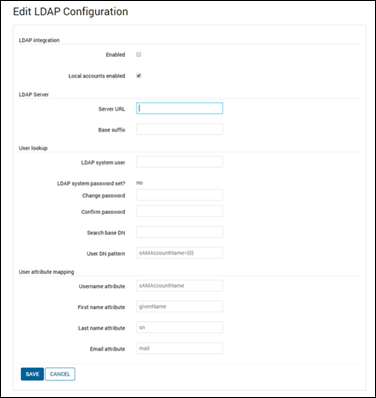LDAP Configuration Page

Edit LDAP Configurations
The following table describes each of the fields on this page and its operation. On installation of Xpress Insight some of these fields will be defaulted to a typical value for AD configuration.

|
Note If LDAP enabled state is changed within
Xpress Insight a restart of the
Xpress Insight Server is not required. User authentication is performed based on the current value of the LDAP enabled field.
|
| Field | Mandatory | Description |
|---|---|---|
| Enabled | Controls whether LDAP is enabled or not. | |
| Local accounts enabled | Controls whether accounts marked as local can access Xpress Insight. See Local User Accounts for more details on this.
Note If this field is unchecked all user account that are marked as local accounts will not be able to log into the system.
|
|
| Server URL | Yes | The URL of the LDAP server, including For example:
|
| Base suffix | Yes | Base suffix from which all operations should origin AD Example: DC=corp,DC=mycorp,DC=com LDAP Example: dc=sample,dc=com |
| LDAP System user | Yes | The user account to use to access the LDAP server. AD Example: CN=myServiceAccount,OU=Windows Service Accounts,OU=Accounts,DC=corp,DC=mycorp,DC=com |
| LDAP System password | Yes | The LDAP system user password. |
| Search Base DN | No | Base DN where the search should begin AD Example: ou=User Accounts, ou=Accounts LDAP Example: ou=Users |
| User DN Pattern | Yes | User DN pattern. LDAP example: LDAPUserDnPattern=uid={0},ou=Users AD example: (sAMAccountName={0}) |
| Username attribute | Yes | This maps the Xpress Insight username to the corresponding LDAP attribute within the user record. LDAP example: uid AD example: sAMAccountName |
| First name attribute | Yes | This maps the Xpress Insight first name to the corresponding LDAP attribute within the user record. LDAP example: cn AD example: givenName |
| Last name attribute | Yes | This maps the Xpress Insight last name to the corresponding LDAP attribute within the user record. LDAP example: sn AD example: sn |
| Email attribute | Yes | This maps the Xpress Insight email address to the corresponding LDAP attribute within the user record. LDAP example: mail AD example: mail |

|
Note If LDAP is enabled, Tableau is configured with
Xpress Insight and has been set so that
Xpress Insight manages the user accounts in Tableau, it is assumed that Tableau has been configured to also use Active Directory.
|
© 2001-2019 Fair Isaac Corporation. All rights reserved. This documentation is the property of Fair Isaac Corporation (“FICO”). Receipt or possession of this documentation does not convey rights to disclose, reproduce, make derivative works, use, or allow others to use it except solely for internal evaluation purposes to determine whether to purchase a license to the software described in this documentation, or as otherwise set forth in a written software license agreement between you and FICO (or a FICO affiliate). Use of this documentation and the software described in it must conform strictly to the foregoing permitted uses, and no other use is permitted.

